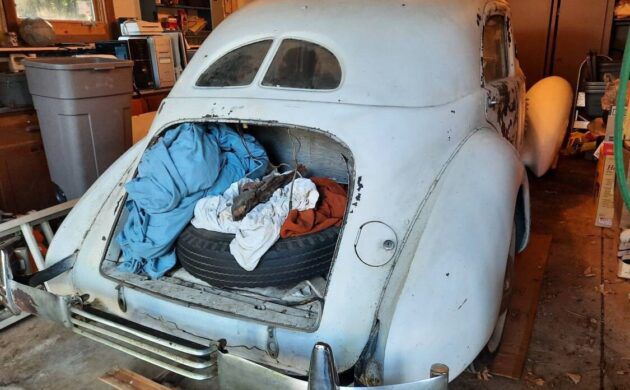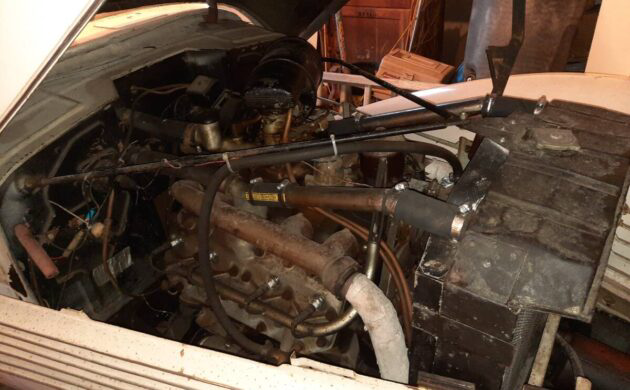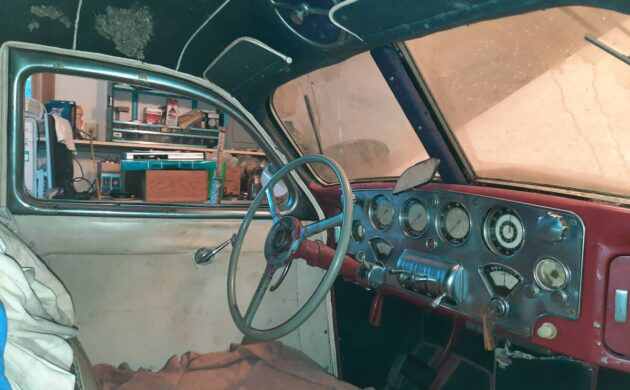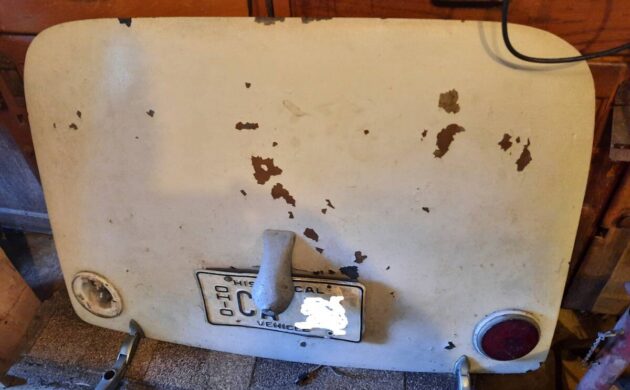The 1936-37 Cords were advanced for their time. The 810/812 were the first domestic, mass-produced automobiles offered with front-wheel drive. Their styling was unique, and plans were to build as many as 1,000 of these a month, but the capital was never there for such a bold undertaking and Cord folded after two years. This 1936 810 is a Westchester which equates to a 4-door luxury sedan. It’s been in the same family for about 45 years but was last driven around 2007. Some older restoration work was done, but much of it may need redoing due to the passage of time. Located in Westerville, Ohio, this unique piece of automotive history is available here on craigslist for $10,000. Thanks for the cool garage find, T.J.!
With the use of FWD, Cord was able to lower their cars, making running boards unnecessary. The 810 (called 812 in 1937) featured an “alligator” style hood hinged at the rear, “coffin” front-end styling, concealed door hinges, and teardrop-shaped fenders. The disappearing headlights were individually raised and lowered by hand cranks located on the dash in front of the driver and passenger. Many of these features influenced competing designs in the future. However, with so many new goodies from a company operating on a shoestring, Cords gained a reputation for being gorgeous, but unreliable.
Production estimates vary but land at around 3,000 Cords being built over its two-year lifespan. Perhaps two-thirds came in 1936, the year the seller’s car was produced. An 814 was planned for 1938, but the well ran dry before Cord could make it through 1937. All Cords were powered by a 289 cubic inch V8 that mustered about 125 hp. Being heavy cars at nearly 4,000 lbs., they were more cruisers than anything else.
At the time we discovered this car, a sale was already pending, but not finalized. The seller’s father, a mechanic by trade, bought this 810 in the late 1970s. From then until maybe 15 years ago, he rebuilt the transmission and had the main shaft reworked. The V8 engine was rebuilt in the late 1950s but is likely tired by now. During the time the car was an actual runner, it was driven several times to the annual Auburn, Indiana Labor Day Meet and sometimes in a parade. When not in use, the car was always in a garage.
Once the Cord can be made to run again, the body will need some massaging before applying new paint. The trunk lid is off and stored separately because the latches dry rotted, and mice damaged the headliner. One of the hidden headlights is not attached at the top and the front fenders were replaced with fiberglass ones when metal units were unavailable. This could be one cool automobile to get going again, but you’d probably need to join the Cord inner circle to know where to find stuff.






Good write up Russ, you pretty much covered all the quality design features of the Cord. The advanced design and the drivetrain was so far ahead of any other manufacturers. Transmission failure was a real problem, shifting the transmission were simple electric solenoids. Sounds good but switch and wiring and solenoid working together was a problem. Was a great idea the failed in practice.
A company called Acdco bought every leftover part from Auburn-Cord and has been selling them for years, along with building “new” cars from them. A replacement trans can be had for the paltry sum of $13,500. I would be inclined to go restomod on this one.
You forgot that you could get the supercharged V8. The trans problems besides the shifter was the oil pump, and the u-joint design for the front half shafts. After Cord folded Hupmobile and Graham-Paige used the body but with rear drive. If your ever in Auburn Indiana you have to see the Auburn Cord Duesenburg Museum
I was in Auburn about 3 years ago for an AACA event and visited the museum. Best car museum I have ever seen.
Being ahead of its time was a double-edged sword for Cord. It would take years, or even decades, for others to catch up to Cord’s design and front wheel drive technology. Unfortunately, the tooling required to build Cord’s curvaceous body was leading-edge and very expensive. Cord didn’t have the capital, so the cars were built with smaller panels that required a lot of costly finishing. Likewise, the constant-velocity joints available at the time were expensive and not particularly durable. A larger automaker would have had the money to overcome all of this, but it was too much for Cord.
Assuming I had the money, skills, and one garage space, each day I pick one car I like and one “no way”. Today the chopped Studie gets the no way and the Cord the Yes.
Post has been deleted….
The 1966 Toronado contains many design features as a tribute to Cord. Compare the front wheel drive, fastback roof, grill vs Cord side hood gills, wheel fender arches and the wheels with the cooling holes. Cool stuff!
Good looking car!